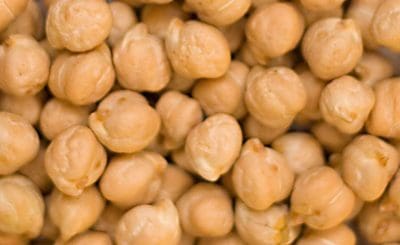AUSTRALIA’S chickpea exports in April totaled 70,963 tonnes, a 35-per-cent drop from 109,404t shipped in March, according to the Australian Bureau of Statistics’ (ABS) latest export data.
 As India continues to shun imports in the face of its large chickpea harvest, Pakistan on 34,805t and Bangladesh on 27,392t remain Australia’s only volume markets for now.
As India continues to shun imports in the face of its large chickpea harvest, Pakistan on 34,805t and Bangladesh on 27,392t remain Australia’s only volume markets for now.
Third and fourth place for Australia chickpea shipments for April went to the United Arab Emirates on 2726t and Iran with 984t.
Containerised exports to secondary and tertiary markets around the globe are expected to absorb any unpriced tonnage in the months leading up to October, when Australia’s new-crop chickpeas will hit the market.
Rain needed
While some late plantings may take place in Australia’s chickpea-producing areas in Queensland and northern NSW, at least 90pc of the estimated planting area is now in the ground.
AGT Foods Australia chief executive officer, Peter Wilson, said while pockets of the 2018 chickpea crop were in reasonable condition, much of the crop was struggling.
“It doesn’t look very good at all. We need a lot of rain and we need it quickly, but the odds of getting it get lower every day because the three driest months for Queensland are July, August and September,” Mr Wilson said.
“We need way above-average rainfall to get a below-average crop.”
Chickpeas in Queensland and northern NSW have in past years been sown as late as July and still achieved average yields.
“However, that gives them a narrow growing window before the weather gets hot, so we do have potential for more area to go in, but it comes with a risk.”
Smaller crop
Australia is estimated to have produced around 1.2 million tonnes (Mt) of chickpeas in 2017, down from the record 2016 production of 2Mt from a record planted area which received the kindest of growing conditions.
Some 2017 crops picked up yield at the end of their growing season, as late rain sparked a final flowering which allowed more pods to set.
The same could happen to the 2018 crop, but its yield prospects are generally seen as lower than last year’s plantings because of reduced and deeper subsoil moisture.
Based on reduced planted area, and uncertain yield prospects due to limited soil moisture, industry sources believe Australia’s 2018 production could be half the 2017 figure.
“This issue isn’t how we’ll market our chickpeas, it’s what we’ll have to market.”
| Destination | Feb | Mar | Apr | Total tonnes |
| Bangladesh | 25790 | 85769 | 27392 | 138951 |
| Canada | 749 | 1359 | 568 | 2676 |
| Egypt | 1172 | 516 | 127 | 1815 |
| Germany | 24 | 0 | 0 | 24 |
| Greece | 0 | 0 | 25 | 25 |
| India | 0 | 0 | 1 | 1 |
| Iran | 969 | 934 | 984 | 2887 |
| Israel | 529 | 25 | 243 | 797 |
| Italy | 146 | 125 | 100 | 371 |
| Japan | 21 | 21 | 42 | |
| Jordan | 325 | 363 | 554 | 1242 |
| Korea | 42 | 0 | 0 | 42 |
| Lebanon | 138 | 24 | 129 | 291 |
| Malaysia | 245 | 288 | 243 | 776 |
| Mauritius | 122 | 100 | 193 | 415 |
| Nepal | 360 | 0 | 0 | 360 |
| Netherlands | 48 | 0 | 0 | 48 |
| New Zealand | 46 | 93 | 31 | 170 |
| Pakistan | 12808 | 10760 | 34805 | 58373 |
| Papua New Guinea | 5580 | 7 | 1 | 5588 |
| Poland | 0 | 0 | 48 | 48 |
| Portugal | 46 | 500 | 751 | 1297 |
| Saudi Arabia | 950 | 1276 | 608 | 2834 |
| Singapore | 24 | 24 | 0 | 48 |
| South Africa | 48 | 48 | 50 | 146 |
| Spain | 25 | 100 | 25 | 150 |
| Sri Lanka | 126 | 0 | 25 | 151 |
| Taiwan | 0 | 18 | 0 | 18 |
| Thailand | 7 | 3 | 26 | 36 |
| Turkey | 0 | 465 | 0 | 465 |
| UAE | 2044 | 4243 | 2726 | 9013 |
| UK | 1309 | 1509 | 828 | 3646 |
| USA | 1511 | 784 | 409 | 2704 |
| Yemen | 69 | 50 | 50 | 169 |
| TONNES | 55252 | 109404 | 70963 | 235619 |
Table 1: Data released by the Australian Bureau of Statistics showing Australian chickpea export data for April 2018, with revised March 2018 figures and February 2018 figures.

HAVE YOUR SAY